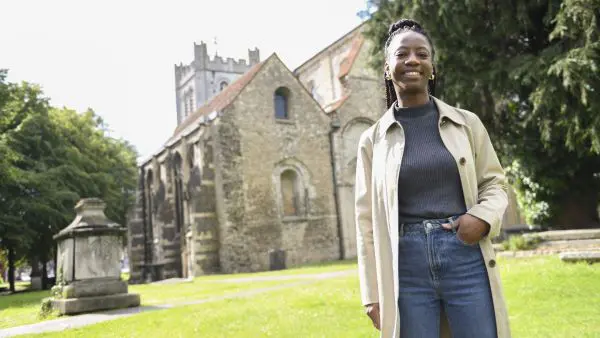We Built This #2: Dami Sanda on Waltham Abbey Church, Essex
Posted on: 10 July, 2024

In the second feature of our We Built This series, we sat down with Dami Sanda, Principal Design Officer with Thurrock Council and a member of Black Females in Architecture, to discuss her connection with Waltham Abbey Church.
From residential houses and urban spaces to bridges, towers and skyscrapers, the products of the built environment affect everyone on the planet and leave a lasting legacy that can inspire people for generations to come.
As part of Be Part of the Change, we’re talking to built environment professionals across the sector to celebrate their incredible achievements and encourage new people to join our sector. We’re asking each member of the sector to tell us about the buildings, communities and infrastructure projects that inspire them or they have been a part of in the UK and across the world.
Our second installment for We Built This is from Dami Sanda, Principal Design Officer with Thurrock Council and member of Black Females in Architecture.
We talked to Dami Sanda about Waltham Abbey Church, in Essex
 Which building is this?
Which building is this?
This is Waltham Abbey Church in Essex. It’s located on the Essex border with Hertfordshire, along the eastern side of the River Lee and the Lee Valley, and can be easily reached via junction 26 of the M25.
What do you love about it?
It’s a really special building: if you go inside it’s got these really tall ceilings with fluted aspects to it, and lots of stained glass windows. If you look up during a service you can see star signs painted on the ceilings – it’s little details like that which stick in your mind. It’s also what fascinates me, as I trained as an architect!
I also really like where it’s situated. This church is at the heart of Waltham Abbey, and it’s the first recognisable building that you see when you enter the area. If you took the same church and put it in more dense surroundings, it wouldn’t be the same. It’s a real focal point of the community, and it’s got beautiful gardens with trees and walls. I did a lot of walking around there during lockdown.
What’s your connection to the building?
I grew up in the area and I used to come here to go to church with my family. My school had a lot of links with the church as well, and we’d go there for Christmas events and to sing in the children’s choir.
It’s important to have that connection with place – it preserves those memories and helps us to feel connected not just to our communities now, but also to the generations that have gone before us.
Learn more: We Built This #5: Laura Bell McMillan on Chester Northgate Tesco Express, Chester
What do you think makes this a significant building?
Apart from its beauty, it’s significant that this church has survived for so many centuries, when there are plenty of older buildings that haven’t.
Standing outside this church makes me think about the places we’re building now … how many will still be around in 1,000 years’ time, and what will that say about our time?
There’s something very unique about historic buildings like this which have survived the test of time.
To find out more about Be Part of the Change and get involved, visit the homepage. If you’d like to get in touch with our Student Ambassadors for EDI, email outreachandinclusion@ucem.ac.uk
To read the previous entry in our We Built This campaign, click here.



 Which building is this?
Which building is this?

